Building Market Access Competencies for the Future
Pharmaceutical Executive
An industry-based working group presents a common standards and definition framework for “Access” competencies in pharma-as a starting point in solving the current shortage of talent and leaders for this widening set of activities.
A nearly universal challenge faced by pharmaceutical companies today is the increasing shortage of competencies and talent in market access. In contrast to well-established functions like marketing and finance, the role of “Access” is often ambiguous and lacks a common nomenclature and standard. The fact that Access has evolved rapidly in the past decades and continues to span an ever broadening set of activities only adds further to the lack of clarity around Access. At the same time, Access becomes increasingly business-central as the topics that fall within its purview fundamentally impact and are critical to the core of a pharmaceutical company’s business and success.
Convening power
The Boston Consulting Group (BCG) Market Access Roundtable is a forum that brings together senior pharmaceutical leaders in market access and serves as a platform for interactive discussion on industry level topics.
In light of the changing role of market access, the Roundtable members created a working group with the goal of developing a common set of standards and terminologies for market access competencies of the future. This paper summarizes the outcome of the work conducted over the past year.
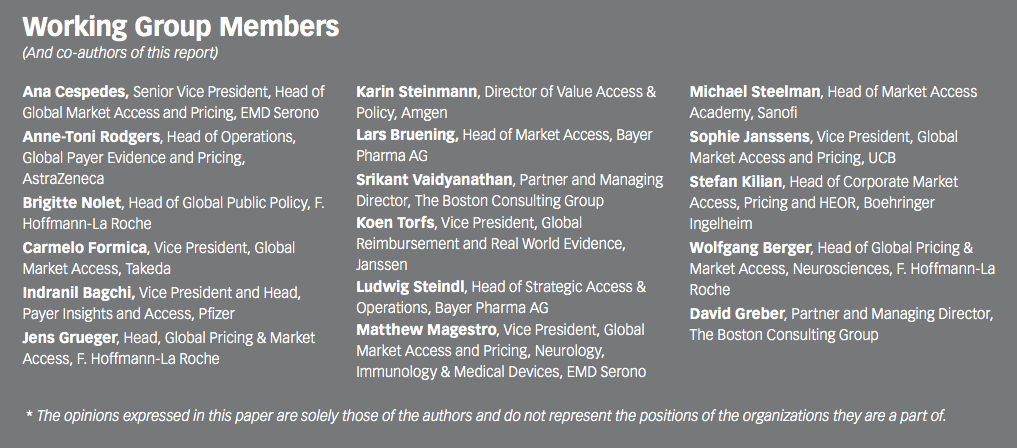
Statement of problem
Access: An increasing shortage of competencies and talent
There is a shortage of Access-related competencies and talent. While most people would agree that Access is becoming increasingly important and pervasive, it could be considered ironic that the definition of the term “Access”-the activities that fall within its broadening scope, and the role they play in today’s pharmaceutical industry-are anything but clear or consistent.
The ambiguity of the role and activities of market access becomes even more striking if one compares Access with other functional domains such as finance and marketing. Those functions today benefit from clear definitions of their roles and activities, and are part of an established nomenclature and standard.
In general, a typical finance or marketing career path is relatively well-defined, has been trodden by many over time, and has well-marked entrances and exits. Consequently, training such as MBAs and specialist courses have emerged to develop talent and prepare its students to step into these clear career paths by assuming expert or leadership roles within those domains. We would venture to say that the current status for such roles can be attributed to clarity as to the roles, activities and competencies that are required within functions like marketing and finance.
In contrast, Access has historically been far more difficult to define, especially as it has changed significantly over the past decade. It has become increasingly important, moving beyond a pure technical role to a far more business-critical and central role. Despite this, the transition into and out of market access roles remains vague and can be summarized simply as difficult to get into, difficult to get out of. We believe these challenges demonstrate a need for the industry to provide clarity on what Access covers, as well as the competencies that are required to support it.
Toward a common terminology and standard
We believe a common set of standards and terminology could serve as a first step for the pharmaceutical industry to define and develop Access talent-development. This would enable company managers, in general, and HR practitioners, specifically, to better understand the Access domain, where it fits within an organization and how to make more informed and better decisions on developing Access talent. Finally, we would also see this as a crucial first step in establishing a minimum standard toward which organizations, both within the industry and potentially also academic institutions, could aim.
An evolving and dynamic discipline
Few would dispute that Access as a discipline is continuing to evolve at a tremendous rate. Historically, Access could be characterized as an art and it was primarily focused on stakeholder relationship management. During the 1990s and 2000s, it shifted toward the technical and scientific side, particularly with its economic focus on assessment models that could be used to demonstrate product value. Today, Access has arguably evolved even further, and in some respects has come at least partially full circle-back toward being an art form that blends technical requirements and the need to shape and influence a multitude of diverse stakeholders.
Today, Access increasingly assumes a central role as the topics that fall within its purview fundamentally impact and are critical to the core of a pharmaceutical firm’s business and success (see Figure 1 below). We see Access considerations and their importance occupying a far greater role in the future, and would venture to say that in five years, if it is not already, it will be perceived as a functional pillar that is as significant as commercial and medical are today.
Figure 1: Multiple trends are driving the evolution of access-related competencies.

Illustrative trends such as increasing real-world evidence (RWE) requirements (often following conditional approval and early benefit assessment), increasing price transparency, the rise of high-value combination therapies, disease chronification and the emergence of more curative therapies are all illustrations of Access issues at the core of how modern pharmaceutical companies need to organize, strategize and execute.
Viewed through a product lifecycle lens, Access is also becoming a far broader discipline (see Figure 2 below). While Access initially focused on the period immediately prior to and during launch (e.g., to synthesize evidence to support reimbursement applications), Access requirements have spread to encompass both earlier periods (e.g., providing input into R&D on evidence requirements, providing key inputs into business planning during development, shaping assessment methodologies and identifying and shaping policies to positively affect change) and later periods (e.g., engaging with sub-national payers to overcome local and regional concerns, shaping tender and contracting policy and managing pricing during loss of exclusivity).
Figure 2: Overview of common access-related activities.
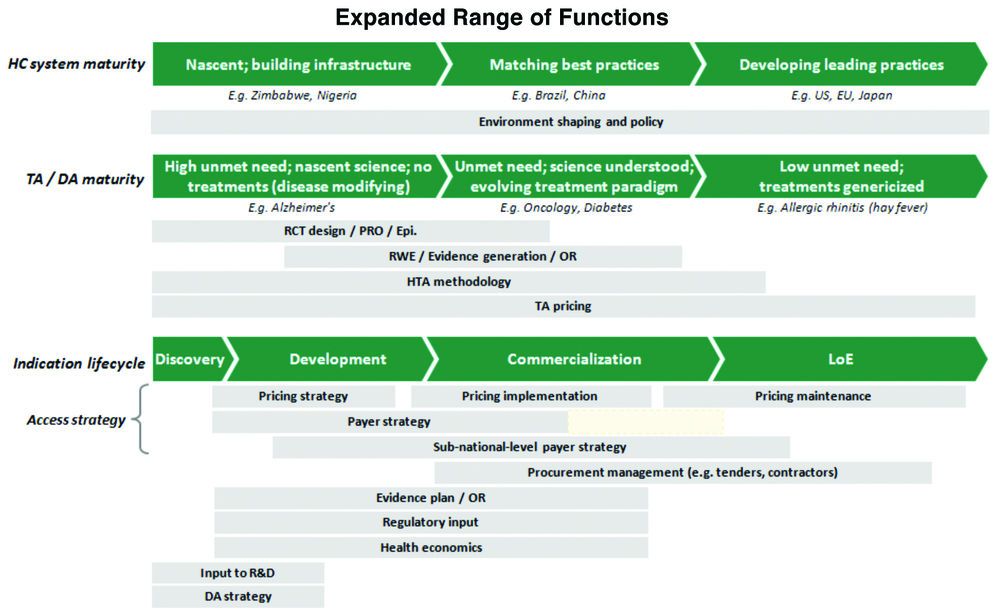
Within the context of this steadily growing span of activities and business-critical topics, it is more difficult to define exactly what Access stands for, and what types of competencies it requires. To facilitate a common understanding, we believe it is important to embrace three changes in our general understanding and definition of Access competencies (see Figure 3 below).
First and most critically, we see an increasing need for identifying a new type of competency that would allow an individual to effectively operate as an organizational point person for Access. Operating within a matrix-like structure, we see this as a necessary competency to provide the connectivity with technical access domains and the rest of the business (e.g., marketing, medical, development, etc.). Previously, such roles were not explicitly visible, and were often roles at least partially assumed by experts within pricing and reimbursement or health economics and outcomes research (HEOR) functions. We see this as a highly strategic competency that is critical for better integrating and enabling collaboration of access activities and issues into the business mainstream.
Secondly, we would propose to split the spectrum of responsibilities that fall within pricing and reimbursement into two new competencies: a pricing competency, that embraces all activities around developing and executing strategic and operational pricing, and an evidence (e.g., health technology assessment [HTA]) synthesis competency, which includes many of the activities and competencies previously falling under the broad banner of reimbursement (such as the development of value propositions to obtain successful payer and HTA appraisals).
Finally, we suggest reclassifying HEOR and acknowledging that it accommodates two very differing competencies. Much of the health economics component (e.g., HTA, epidemiological models, etc.), we would argue is more akin to an evidence synthesis competency, while outcomes research is a distinct competency unto itself that could be classified as evidence generation.
Figure 3: The transition toward a common definition of access competencies.
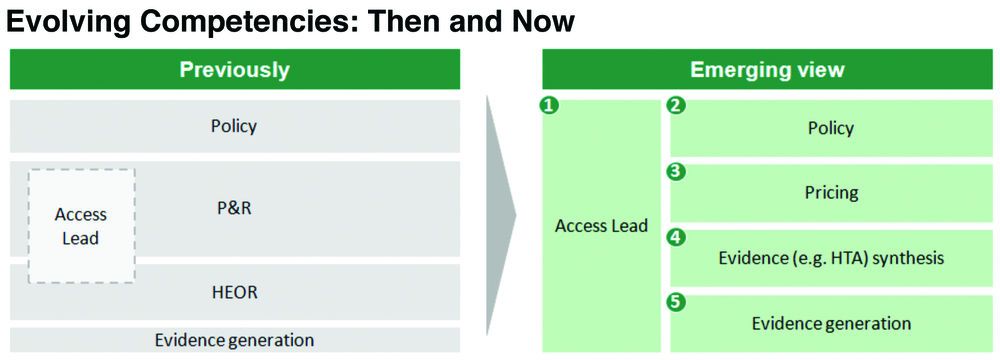
Competency descriptions
Our intent in laying out the following competency descriptions is to define the core competencies that fall within the remit of an Access domain. We have deliberately avoided any form of prescription through job definitions or titles, as we recognize that different pharmaceutical firms will divide and blend these competencies as their needs require. Our intent is to describe the core competencies that we believe every successful global market access organization will need to exhibit.
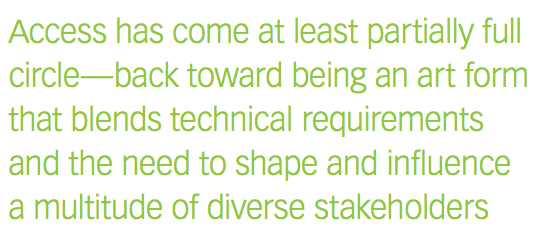
As a starting point, we have selected a set of five competencies that cover the majority of roles and activities that we see in Access today: Access lead, policy, pricing, evidence (e.g., HTA) synthesis and evidence generation. We believe that these competencies are universally applicable across all pharmaceutical companies, although we would see them as the global level competencies that are typically required in mid-to-large organizations. In many companies, and in particular at the regional and local levels, many of these core competencies can and will be conducted by the same person with multiple competencies.
1. Access Lead
Objective: Leads access strategy and implementation through:
Shaping and developing strategy
- Anticipating a changing landscape, including emerging trends that can affect Access thinking of all stakeholders (e.g., payers)
- Driving development and implementation of strategies to secure/maintain Access at optimal prices
Enabling cross-functional collaboration
- Ensuring and leading close partnership within access functions to align strategy, policy, pricing, evidence synthesis and evidence generation
- Integrating access considerations into other functional domains (e.g., commercial, medical, regulatory, clinical)
Building access capabilities
- Driving the creation of an access mindset through training and other communication initiatives
- Ensuring capabilities across access functions are developed and maintained along the product lifecycle
2. Policy
Objective: Creates a positive and beneficial access environment by:
Generating insights
- Monitoring the relevant policy environment
- Understanding key healthcare trends and their effect on market access-related decision makers
- Identifying policy priorities and objectives to overcome key access barriers
Developing strategies
- Developing policy positions that address access barriers, support patient choice and ensure a sustainable pharmaceutical industry
- Generating disease impact policies
- Supporting and leading strategies and implementation plans that shape favorable access and funding environments and appropriate uptake of products
Advocating
- Developing network of contacts with key policy stakeholders
- Identifying and educating advocacy groups to inform policymakers
- Supporting communications and media relations activities to achieve policy objectives
3. Pricing
Objective: Develops and executes strategic and operational pricing through:
Generating insights
- Monitoring evolution of relevant P&R systems and HTA policy
- Anticipating trends, competitors, and prices across markets
- Tracking and managing company pricing and reimbursement decisions
Strategic pricing
- Conducting research and analysis to understand P&R drivers
- Providing input into evidence-generation plans
- Shaping target product profiles (TPPs)
- Developing and implementing pricing strategy throughout product lifecycle
- Developing general pricing guidance (e.g., TA pricing, pricing corridors)
Operational pricing
- Managing engagement and negotiations with payers to achieve local P&R
- Developing and implementing market access solutions (e.g., innovative contracting, patient access schemes)
- Understanding access implications for other business/function decisions
4. Evidence synthesis
Objective: Develops product value propositions to obtain successful payer/ HTA appraisals by:
Shaping requirements
- Monitoring evolving HTA technical requirements and shaping new methods with external partners
- Providing input into, reviewing and shaping evidence generation plans (e.g., comparator, target patient populations, endpoints, QoL data, etc.)
- Providing early scientific advice
- Driving clinical/medical teams to fill evidence gaps (e.g., indirect comparison, subgroup analysis, etc.) and build integrated evidence packages
Demonstrating value proposition
- Building HTA models to demonstrate value proposition and predict budget impact
- Designing, executing and analyzing HTA studies to create value messages that resonate with payers and other stakeholders
Submitting evidence and engaging
- Synthesizing and submitting P&R applications including HE value dossiers
- Engaging with HTA authorities along the product lifecycle to preempt and respond to technical concerns
5. Evidence generation
Objective: Supports the identification and generation of evidence that will support optimal access by:
Shaping environment
- Monitoring evolving evidentiary requirements (including epidemiology) that affect successful negotiations and reimbursement
- Technical negotiation with HTA and payer authorities on evidence strategies, and clinical and RWE development plans
Generating evidence
- Developing cross-functional evidence strategies and generation plans that support reimbursement for both clinical and RWE
- Collaborating with and reviewing clinical science to ensure capture of clinically reported outcomes and patient-reported outcomes as required
- Ensuring evidence is delivered to and interpreted for HTA to enable successful HTA appraisal
Where do we go from here?
We recognize that the setting of standards and definitions will not by itself solve the current shortage of access talent and leaders. We hope it serves as a first step for at least three stakeholders to take action:
- For individuals to understand more consistently and holistically what activities fall within the core of Access, and what roles Access plays within an organization
- For pharmaceutical companies to better define where they have access competency gaps, and to define career paths and roles that can develop Access leaders
- For educational institutions to take up and design educational offerings that develop Access leaders from technical experts, and bring non-Access specialists into the Access realm
Collectively, we are confident that tackled from multiple angles, the increasing need for Access practitioners and for an increased understanding of Access more generally can be achieved.
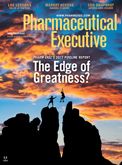
The Misinformation Maze: Navigating Public Health in the Digital Age
March 11th 2025Jennifer Butler, chief commercial officer of Pleio, discusses misinformation's threat to public health, where patients are turning for trustworthy health information, the industry's pivot to peer-to-patient strategies to educate patients, and more.
Applying Porter’s Five Forces to Portfolio Management in Pharmaceutical R&D: A Strategic Roadmap
March 17th 2025The increasing costs and complexity of R&D in the pharmaceutical industry have necessitated the adoption of strategic portfolio management to optimize resource allocation and enhance competitive advantage.
Navigating Distrust: Pharma in the Age of Social Media
February 18th 2025Ian Baer, Founder and CEO of Sooth, discusses how the growing distrust in social media will impact industry marketing strategies and the relationships between pharmaceutical companies and the patients they aim to serve. He also explains dark social, how to combat misinformation, closing the trust gap, and more.